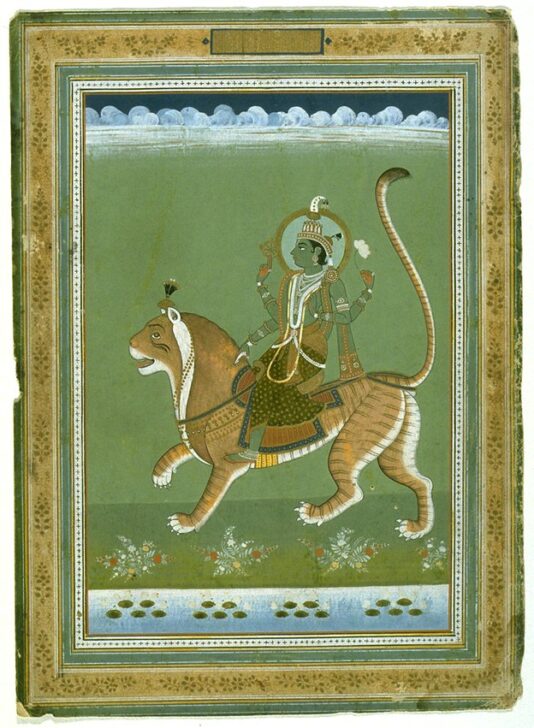Page from an Indian zodiac manuscript: Figure Mounted on a Tiger (possibly Saturn)
Artist Unknown, India, Rajasthan, Jaipur School

Description
Gallery Rotation Winter 2013
Iconography series: Saturn, mounted on a tiger
India, Rajasthan, Jaipur School
circa 1840
Ink, opaque watercolor, and gold on paper
Gift of Professor Walter M. and Nesta R. Spink, 1987/1.248
In Sanskrit, Saturn is called Shani or Shanaishchara (the slow mover) because it takes thirty years for it to orbit the sun. Shani is also known for being strict and punishing those who follow the path of evil, betrayal, backstabbing, and unjust revenge. Typically he is depicted with dark skin, holding a bow and arrow, and riding upon or in a chariot pulled by a crow or vulture. As the protector of property Shani is able to repress the tendency of these birds to steal.
In this image Shani is seen mounted on the back of a tiger, the national animal of India and typically the vehicle of his sister, the Hindu goddess Durga. Shani also holds a white lotus, a scepter, and a Shani shankh (conch shell), used to appease him and invite his blessing.; Attributed to Jaipur School
Pages from a set of miniature paintings (left-right, top-bottom):
Vishnu on a Bird, Elephant-Headed Figure on a White Bird, Princess
Mounted on an Elephant, Figure Mounted on a Tiger (possibly Saturn),
Dhanus (possibly Sagittarius)
India, Rajasthan
20th century
Ink, opaque watercolor, and gold on paper
Gift of Walter M. and Nesta R. Spink,
1987/1.249, 1985/2.138, 1985/2.136, 1987/1.248, 1985/2.137
Miniature painting illustrating both religious and secular texts has
existed in various forms in India since the ninth century. The art
form reached its zenith under Mughal rule (1526–1857), when painters
combined Persian and Indian styles with European influences brought
to India by Jesuit missionaries. In this set of paintings the main Hindu
gods and goddesses are mounted on their vehicles (Sanskrit: vahanas).
The dark-blue-bodied Vishnu, for example, is riding a grey bird,
possibly his mount, Garuda, but the other leaves depart from standard
iconographies. Ganesha, for example, rides a peacock rather than the
more typical rat. These unusual paintings are in the Jaipur school style
of Rajasthan, which is characterized by bold lines and vibrant, sharp
colors. They may have been produced for the Western market, rather
than for use in the local courts.
2021 Gallery Rotation
__________
Anonymous
Page from an Indian zodiac manuscript:
Figure Mounted on a Tiger (possibly Saturn)
India, Rajasthan, Jaipur school
ca. 1840
Ink, opaque watercolor, and gold on paper
Gift of Professor Walter M. and Nesta R. Spink, 1987/1.248
Subject Matter:
This is part of a series on Hindu deities and objects and animals associated with them. In this image Shani is seen mounted on the back of a tiger, typically the vehicle of his sister, the Hindu goddess Durga. Shani also holds a wheel/chakra, white lotus, scepter, and a Shani shankh (conch shell), used to appease him and invite his blessing.
Physical Description:
Two figures, Shani and his tiger are depicted centrally in the image. The background is very simple with some grass tufts and a pond near the very bottom of the images.
Usage Rights:
If you are interested in using an image for a publication, please visit https://umma.umich.edu/request-image/ for more information and to fill out the online Image Rights and Reproductions Request Form.